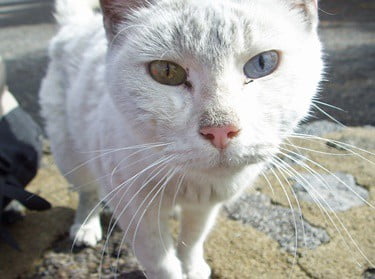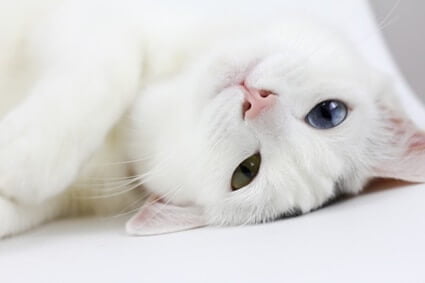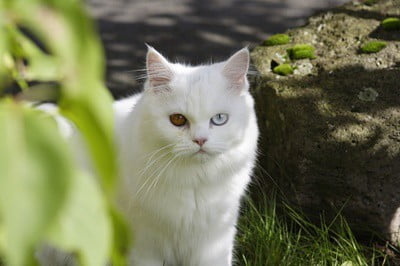Some cats have heterochromia iridis, which is an unusual condition that means the iris in each eye is a different color. The result is a cat with one blue eye and the other either green, yellow, or brown.
Cats have different eye colors (odd eye syndrome) when melanin fails to develop in one of the eyes, resulting in one blue eye and one that reflects the cat’s eye color. All kittens are born with blue eyes because they have no melanin in the iris. Heterochromia can either be genetic or acquired.
Even though odd eyes are a genetic defect, many people see heterochromia as a trait that adds to the cat’s uniqueness. Cats with this condition fetch more money than cats with normal colored eyes.
Why Do Cats Have Two Different Eye Colors?
An odd-eyed kitten is a term used to describe a cat with two different colored eyes.
As discussed, this is caused by a condition called heterochromia iridium, a genetic anomaly most commonly found in white cats.
It’s not a medical condition, and it doesn’t cause any problems for the affected cats. While it might appear alarming, cats with heterochromia (odd eye syndrome) can see perfectly.
Cats get their eye color from pigment-producing cells in the iris called melanocytes. If no melanocytes are present, the eyes will be blue. A low number of melanocytes will cause green eyes, while a high number will cause orange eyes.
Active melanocytes will create a more intense color, while less active melanocytes will produce a lighter eye color. Which one applies is determined by the cat’s genetics.
There are three types of heterochromia iridium:
| Complete heterochromia: | The cat’s eyes have two independent colors. For example, one might be blue and the other green. Sometimes a cat’s genes will prevent melanin from reaching one of the eyes, so one will remain blue. | |
| Sectoral heterochromia: | The iris of a single eye features two colors. For example, one eye might contain a mixture of blue and green. It happens when various levels of melanin spread throughout one iris. | |
| Central heterochromia: | Different colors within the iris appear spiked or haloed. |
Heterochromia iridium can be hereditary from birth or acquired due to illnesses or medical problems.
Hereditary Heterochromia Iridis
A cat’s genes determine the pigmentation.
All kittens are born with blue eyes because there’s no melanin in the iris. When a kitten reaches 7-12 weeks of age, melanin moves into the iris and changes the eye color.
Unless health issues or diseases occur later in life, this eye color is permanent. The amount of melanin that moves into the iris will determine a cat’s actual eye color, which is most likely to be brown (including orange tones), yellow, or green.
All-white or white-spotted cats are more likely to carry the heterochromia gene because the dominant white or white spotting gene that makes a cat completely white or bi-colored can interfere with the migration of melanocytes in one of the eyes.
White-furred cat breeds with these genes, like the Japanese Bobtail, Turkish Angora, and the Turkish Van, are more likely to develop the condition.
Acquired Heterochromia Iridis
Acquired odd eyes can’t be passed on to kittens from the affected parent cats. Certain conditions can cause a change of color in a cat’s eye, which usually occurs later.
Conditions that cause acquired heterochromia iridis include:
Uveitis
Uveitis is the inflammation of the eye’s uveal tract, consisting of the iris, choroid, and ciliary body.
It’s a painful condition and, if left untreated, can lead to blindness. Uveitis can be an isolated problem or a symptom of other conditions.
Conditions that cause uveitis include the following:
- Eye trauma
- Bacterial or fungal infection
- Diabetes
- Tumors
- Feline herpes
- High blood pressure
Some cats with uveitis will paw at their sore eye, while others will avoid contact with the eye altogether. Other cats might keep the eye shut and become aggressive if someone tries to go near it.
Most cats with uveitis will avoid bright light because it’ll cause discomfort. Squinting, redness, and eye cloudiness are symptoms of this condition.

Glaucoma
Feline glaucoma is when the watery fluid (aqueous humor) in the front part of the eye behind the lens cannot drain properly. The fluid then accumulates, putting pressure on the optic nerve. Common signs of glaucoma include a cloudy, milky coloration of the eye.
The US National Library of Medicine warns that while glaucoma is relatively uncommon in cats, it’s likely that many cases go unrecognized. It can begin in one eye and spread to the other, leading to blindness.
Portosystemic Liver Shunt
Copper-colored eyes can be a sign of portosystemic liver shunt, which is an abnormal vessel that allows blood from the animal’s intestine to bypass the liver.
The result is that toxins, proteins, hormones, and nutrients absorbed by the intestines bypass the liver. Instead, they’ll circulate throughout the body, causing liver function deterioration.
Not all cats with portosystemic liver shunt will develop copper-colored eyes, but it can be a symptom.
Cat Breeds Most Likely to Develop Odd Eye
Cats with white or bi-colored coats are more likely to develop heterochromia.
According to Cornell Feline Health Centre, white cats with blue eyes are most likely to develop congenital deafness. 80% of white cats with two blue eyes show signs of deafness when they’re about 4 days old due to cochlear degeneration.
Furthermore, a white cat with two blue eyes is 3-5 times more likely to be deaf than a cat with two non-blue eyes. A cat with one blue eye is about twice as likely to be deaf as a cat with two non-blue eyes.
The white gene can cause the degradation of the cochlea and disrupt the melanocyte migration into one or both eyes. The cochlea is an integral part of the inner ear, resulting in irreversible deafness in one or both ears.
The most likely cat breeds to develop odd eye syndrome are as follows:
Japanese Bobtail
Many Japanese Bobtails will develop gold eyes
Cats with heterochromia are most likely to have one blue eye and one gold eye. This is due to their genes, as many have pure white coats or white coats with brown and grey spots.

Turkish Angora
Because the Turkish Angora has either the white or white-spotted gene, both heterochromia and deafness are common conditions of the breed.
Turkish Van
Even though most Turkish Vans are white, heterochromia isn’t the breed’s most dominant feature. There are no Turkish Van cats with green eyes, but they can be amber, blue, or a mixture of both.
Khao Manee
Many Khao Manees will retain at least one blue eye from kittenhood, where the melanin has failed to move to the iris. This is what gives them their unique and highly sought-after look.
A Khao Manee with heterochromia is even more popular than one with two normal eyes.
Sphynx
Their large, round eyes will usually be yellow or light green, while the blue eye is usually vivid and deep in color. This is why odd-eye Sphynxes are such sought-after cats.
How Rare Are Odd Eyed Cats?
Heterochromia is rare in most cats but common in certain breeds.
This condition rarely occurs in dark-haired or black cats because they don’t have the white or white-spotting gene. A cat with white fur won’t automatically develop odd eyes as they grow older, as it’s down to the individual cat’s genes.
To put into context the rarity of odd eye syndrome, white cats make up around 5% of the feline population. Of this, 1-2% of the population will have two blue eyes or one blue eye.


I have a large male cat, possibly tabby/ coon cat mix. Both of his eyes are blue close to the pupil with an amber halo. Is this common? I haven’t been able to find any information